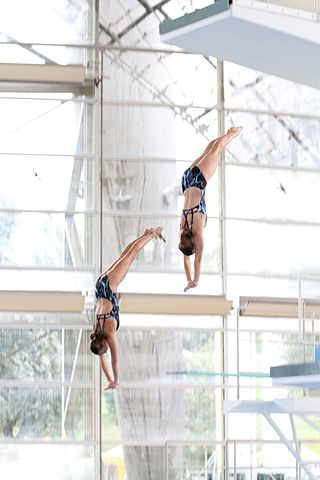World Aquatics, formerly known as FINA, is the international federation recognised by the International Olympic Committee (IOC) for administering international competitions in water sports. It is one of several international federations which administer a given sport or discipline for both the IOC and the international community. It is based in Lausanne, Switzerland.

The European Aquatics Championships is the continental Aquatics championship for Europe, which is organised by LEN—the governing body for aquatics in Europe. The Championships are currently held every two years ; and since 2022, they have included 5 aquatics disciplines: Swimming, Diving, Synchronised swimming, Open water swimming and High diving. Prior to 1999, the championships also included Water polo, which beginning in 1999 LEN split-off into a separate championships. The open water events are not held during the Olympic year.

The London Aquatics Centre is an indoor facility with two 50-metre (164-foot) swimming pools and a 25-metre (82-foot) diving pool in Queen Elizabeth Olympic Park in Stratford, London. The centre, designed by architect Zaha Hadid as one of the main venues of the 2012 Summer Olympics and the 2012 Summer Paralympics, was used for the swimming, diving and synchronised swimming events. After significant modification, the centre opened to the public in March 2014.

Diving was first introduced in the official programme of the Summer Olympic Games at the 1904 Games of St. Louis and has been an Olympic sport since. It was known as "fancy diving" for the acrobatic stunts performed by divers during the dive. This discipline of Aquatics, along with swimming, synchronised swimming and water polo, is regulated and supervised by the International Swimming Federation (FINA), the international federation (IF) for aquatic sports.
Jenna Leigh Johnson is an American former competition swimmer and Olympic gold medalist.

The Singapore Sports Hub is a sports and recreation district in Kallang, Singapore. The Sports Hub is a 35-hectare public-private partnership that is anchored by the new National Stadium and existing Singapore Indoor Stadium, and also incorporates a new aquatics facility, indoor sports hall, water sports centre, public sports facilities, and retail.

High diving is the act of diving into water from relatively great heights. High diving can be performed as an adventure sport, as a performance stunt, or competitively during sporting events.

The 15th FINA World Championships were held from 20 July to 4 August in Barcelona, Catalonia, Spain. The 2013 World Championships featured 6 aquatics disciplines: swimming, water polo, diving, high diving, open water, and synchronised swimming.
Jill Ann Sterkel is an American former competition swimmer, Olympic champion, former world record-holder, and water polo player. Sterkel won four medals in three Olympic Games spanning twelve years from 1976 through 1988. She was the women's head coach of the Texas Longhorns swimming and diving team at the University of Texas at Austin from 1993 to 2006.

The 16th FINA World Championships, also Aquatics 2015, were held in Kazan, Russia from 24 July to 9 August 2015. Russia hosted this event for the first time. The number of participating national teams (190), athletes (2,400) and the number of medals (75) were the most ever amongst these championships. This was the first time the World Aquatics Championships partially overlaps with the FINA World Masters Championships that have a number of athletes, countries (110) and medals (635) which are the most ever also.
David Palmer McCagg is an American former competition swimmer, world champion, and world record-holder. He was the 100 metres freestyle champion at the 1978 World Aquatics Championships in West Berlin.

The 2023 World Aquatics Championships, the 20th edition of the World Aquatics Championships, were held in Fukuoka, Japan, from 14 to 30 July 2023. Originally scheduled to be held in 2021 as the 19th championships, the championships were postponed until May 2022 in response to the rescheduling of the 2020 Summer Olympics in Tokyo to 2021 due to the COVID-19 pandemic. The event was pushed back a second time to 2023 due to ongoing travel restrictions and safety measures in place in Japan. In its place, Budapest hosted the 19th Championships from 18 June to 3 July 2022, while the originally scheduled 2023 championships in Doha, Qatar, were moved to 2024.

Anna Bader is a German high diver. She competed in the 2013 World Aquatics Championships in Barcelona, Spain the Red Bull Cliff Diving World Series in 2013, 2014 and 2015, and the 2015 World Aquatics Championships in Kazan, Russia.

Cesilie Carlton is an American high diver who won the first gold medal at the high diving competition at the 2013 World Aquatics Championships. She defeated her fellow countrywoman Ginger Huber and German Anna Bader to win the gold medal. In 2015, she won the silver medal.
Ginger is an English given name, nickname, and surname.

Singapore Aquatics is the national governing body for competitive swimming, diving, synchronised swimming, water polo and open water swimming in Singapore. SAQ is also charged with selecting the Singapore Olympic Swimming team and any other teams that officially represent Singapore, as well as the overall organisation and operation of the sport within the country.

Great Britain competed at the 2015 World Aquatics Championships in Kazan, Russia between 24 July to 9 August 2015.
The World Diving Championships are a biennial international sports competition organized by FINA since 1973 as part of the FINA World Aquatics Championships.

New Clark City Aquatic Center is a swimming and diving venue at the New Clark City in Capas, Tarlac, Philippines. It is one of the venues of the New Clark City Sports Hub, which is part of the National Government Administrative Center. It hosted the aquatics events of the 2019 Southeast Asian Games and is set to host the 2023 Asian Swimming Championships.
The Abu Dhabi Aquatics Festival was a FINA-organized international aquatics competition spanning the disciplines of open water swimming, diving, and high diving, which took place from 15 to 20 December 2021 on Yas Island in Abu Dhabi, United Arab Emirates. It was held correspondent to the 2021 FINA World Short Course Swimming Championships. The festival was the first time competitions in the three disciplines are being conducted at the same time as and in conjunction with a FINA World Short Course Swimming Championships. In addition to sporting competitions, an interactive village is being provided for festival attendees. Coverage of the aquatics festival on television and via online streaming was provided on six continents with news agencies including ESPN (Americas), SuperSport (Africa), and beIN Sports (Asia) providing international coverage of the high diving competitions.














